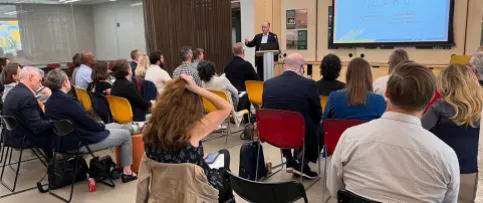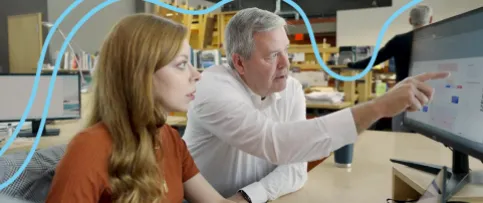Why did you want to become an architect?
In the beginning, I didn’t know I wanted to be an architect. Constructing things has always been a passion of mine—when I was a kid, I loved building forts with my brother and playing in the tiny tree house my dad built, and I was obsessed with my Mega Bloks Fantasy Dream home. When I was in my teens, I couldn’t wait to build stuff in wood shop at school and enjoyed watching my house being built. My grandfather was a carpenter and was always building something from nothing, and I loved every minute I could spend with him. When it came time for college applications, it was my parents who guided me toward the study of architecture. In the end, it was a series of memories and direction from the people closest to me rather than a single moment of realization.
What was your strategy for completing the IDP and ARE?
When I first set out to take the exams, I had no strategy; I didn’t believe I needed one. I thought it would be like taking a test in college: study a few days before, take the test, and move on to the next. But the testing process was a lot more involved than I originally realized, and I ended up failing my first two exams. After that set back, I knew I needed to develop some study habits that I could stick with. By nature I’m a multi-tasker, so being able to combine studying with other tasks in my daily routine was my strategy. I figured out how to study flashcards while being on the elliptical at the gym and used a question-and-answer app during my commutes. I also found that studying in places besides my apartment helped keep distractions at bay.
I was also inspired by a quote I came across by Frank Ocean, “Work hard in silence, let your success be your noise.” I purposefully didn’t tell anyone that I was continuing to take the exams, aside from a few select friends. This took a lot of pressure off, and I didn’t have others influencing my study habits. Study groups and online forums are very helpful for some people, but they just didn’t work for me. The added bonus was surprising people when I completed all seven exams in nine months!
How did you stay motivated to complete the ARE after facing setbacks?
After the devastation of failing my first two exams, it was very difficult to find the motivation to continue, but I knew I hadn’t put my best foot forward when it came to studying. I realized I had to make some changes to my study habits and revise my goals. I think it’s important to be flexible in this process, since it can take a long time. I decided to make smaller daily study goals to keep from feeling overwhelmed. Once I passed the first test, I had such an established study routine that the motivation came naturally. I booked my second, passed, and booked the next. The next thing I knew, I had passed five of the seven exams in six months and thought to myself, “Wouldn’t it be cool to just be done by the end of the year?” I got my final pass on December 11. The consistent small victories kept me focused and on track, turning those setbacks into a thing of the past.
How did completing the IDP at one firm impact your career?
Being able to earn my hours at one firm helped me to receive my license at a younger age. Since I started with Siemasko + Verbridge as an aspiring architect, I was collecting IDP hours while still in college. After getting my master’s degree, I returned to the same firm and picked up where I left off. I had already established relationships with my co-workers and could participate on a more challenging level than if I had started over at another firm. This allowed me to quickly obtain my hours in the experience areas. Working with a few different co-workers allowed me to have access to plenty of different projects at varying phases, so I was able to get the exact hours I needed. It took me five and a half years to fulfill the required hours, and I started taking my exam about four years into my IDP.
Why was earning a license important to you?
I felt getting licensed was just another step toward becoming an architect. Having a license played a huge part when an opportunity presented itself for a different position in Siemasko + Verbridge’s new Chatham office. Working as a licensed architect in a new location over the past year has been challenging and rewarding. Having learned a lot through my path to licensure, I found I had the self-assurance to navigate through new responsibilities. Having my license has instilled more trust in my relationships with clients and co-workers—plus it’s nice to be able to confidently say I’m an architect.
In addition to your architectural projects, you’re also involved with social media and marketing for your firm. How important do you think branding is in architecture?
Over the last five years I have learned more about marketing and branding then I ever imagined. Branding is extremely important to the sustainability of a company. With so many options out there, it’s what sets your firm apart and often determines whether a new prospect will choose to work with you.
Branding is a way to connect visibly and emotionally with your audience on different platforms—not just a page in a magazine or a billboard. It’s your design being built on the busiest street in town that speaks volumes. It’s the community participation that sparks relationships with future clients. It’s the sculptures your company builds on the front lawn to showcase teamwork and creativity. It’s happy clients that refer you to their friends and family. It’s a valuable side of the business that many architects don’t see or participate in, even though they should—after all, you never know when you’ll run into your next client.
What advice do you have for other young women entering the field?
Roughly 26 percent of architects are women, according to the Bureau of Labor Statistics. Some people see that as a small number and a disadvantage, but I feel the opposite. Young women should see this as an opportunity. We are a rarity in the field, which means we bring a different perspective. My advice is to trust and respect yourself. Focus on your path and don’t get bogged down by statistics.
What tools and resources did your firm provide along your path to licensure?
The principals of my firm, Thad Siemasko, AIA, and Jean Verbridge, ASID, have demonstrated every day the importance of licensure both for individual growth and for the success of the firm as a whole. Because of this, they provide a vast amount of tools to help ease the process. Not only do they reimburse employees for passed exams and other fees associated with obtaining a license, they also help with applications and renewal fees. When I petitioned for newer study materials for the office, they listened and provided. They always offer constant support and encouragement, and openly talked about their experiences with testing. Knowing that they went through the same process and would be there to support me offered a little relief in a tense time, allowing me to focus on studying instead of worrying about the little things.
Katelyn Grooms currently works at Siemasko + Verbridge in Chatham, MA.



